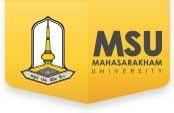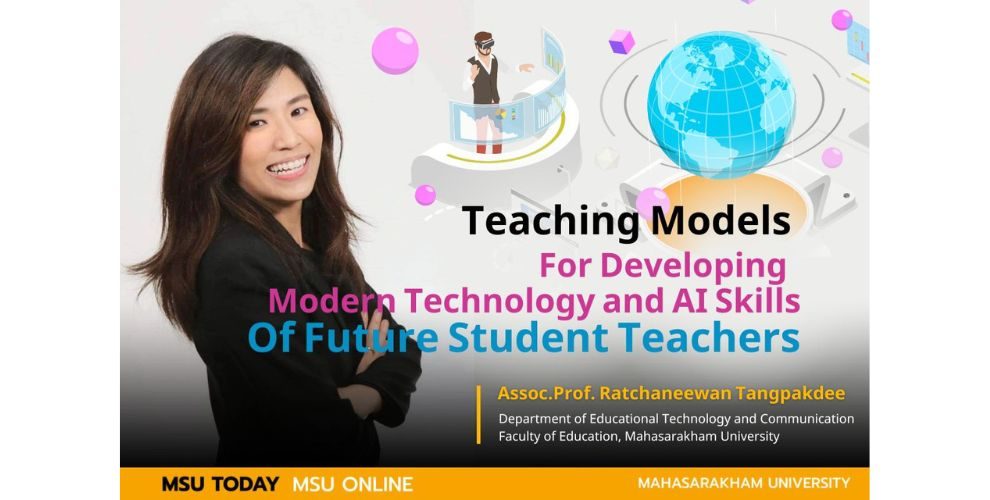Teaching Models for Developing Modern Technology and AI Skills of Future Student Teachers
In an era where technology advances rapidly, artificial intelligence (AI) has become an essential part of every sector of society, especially in education. It is essential to prepare student teachers to have the skills to use technology and integrate AI into their work. Furthermore, it is necessary for them to be able to utilize these tools to create effective, modern teaching and learning materials that align with the current needs of students.
The development of contemporary technology and AI skills for student teachers is extremely important in the present era. It not only helps student teachers to effectively manage teaching and learning, but also prepares them to be future educational leaders who can create diverse learning experiences that meet the needs of each student in a technology-driven world. Under the leadership of Assoc.Prof. Ratchaneewan Tangpakdee, a lecturer in the Department of Educational Technology and Communication, Faculty of Education, MSU, this teaching model aims to develop contemporary technology and AI skills for student teachers.
Project Name:
- iUp EDU Model: Teaching Models for Developing Contemporary Technology and AI Skills of Future Student Teachers

Background of the Research
This research originates from two key points. The first is the awareness of the importance of technological changes that affect work in every profession, including daily life, particularly the rapidly advancing AI in recent years. The education sector, as the starting point for human development, also requires educational personnel at all levels to develop knowledge and skills in these areas. The Department of Educational Technology and Communication has been tasked with teaching the course 0530 101: Information Technology Innovation and Educational Communication, a compulsory course that all first-year Bachelor of Education (B.Ed.) students from 11 programs across 4 faculties are required to take.These students are future teachers or educators who must have knowledge and skills in using contemporary technology and AI. The course outline for this subject designates the five weeks after midterm exams for workshops to install these new knowledge and skills. However, this idea faces practical challenges due to a large number of students, few instructors, a heavy workload, limited resources, and a lack of preparedness. This led to the solution of increasing teaching assistants; however, there is limited budget for hiring a sufficient number of permanent teaching assistants.
The second issue stems from the need to develop a sufficient number of quality teaching assistants quickly, which has led to the integration with the course 0503 343: Computer Teaching Methods, a compulsory course for students in the Department of Educational Technology and Communication for third-year students. According to the course requirements, students must pass practical teaching assessments in computers and serve as teaching assistants, which aligns with the demand for teaching assistants in the course 0530 101 of the department. This has led to the researcher, as the person responsible for the course 0503 343, designing the teaching process to create capable teaching assistants who exhibit effective teaching skills and positive assistant behaviors. The researcher studied various theoretical concepts and considered the learning environment context, finding that experiential learning through real-life teaching practice and co-teaching strategies would help teaching assistants develop diverse skills and effectively apply their knowledge in real teaching situations. Thus, the creation of the iUp EDU Model: Teaching Models for Developing Contemporary Technology and AI Skills of Future Student Teachers emerged.

Research Key Features
The uniqueness of this research lies in the iUp EDU Model, which combines the concepts of Experiential Learning (EL) with co-teaching strategies to create a teaching model that enables learning through real-life experiences. This approach allows learners to actively engage, analyze, and reflect on their learning process, resulting in deeper and more sustainable learning. The co-teaching strategies foster role-sharing within the teaching team, such as having a lead instructor, teaching assistants, and additional support assistants, which promotes collaborative learning and develops communication and teamwork skills, particularly by mentoring less experienced teaching assistants through collaboration with expert instructors. The Micro-Teaching and Teaching Practice activities in the iUp EDU Model allow learners to practice teaching skills in simulated and real situations, enabling them to develop teaching skills, problem-solving abilities, and feedback reception, thus boosting their confidence and expertise.
The iUp EDU Model utilizes diverse teaching techniques each week, such as interviewing actual teachers in schools (Bingo Interview), designing computer labs (Computer Lab Design), sharing teaching expertise from senior students who are current teachers, and reviewing lesson plans. These experiences offer learners multiple perspectives and continuous weekly reflections through a learning cycle, enhancing their self-awareness of progress and improving their learning effectively. The iUp EDU Model employs a systematic approach to data collection and teaching evaluation, which aids both learners and instructors in visualizing overall development and refining future teaching processes.
What is Special About this Research:
- The iUp EDU Model, resulting from the research, has successfully equipped over 1,000 first-year student teachers across 25 classes from 11 Bachelor of Education programs with contemporary technology and AI skills in one semester. Students can apply this foundational knowledge and skills to other courses, part-time jobs, and their future careers.
- The iUp EDU Model is dynamic and flexible, allowing for the adjustment of objectives and content to establish new teaching topics annually. Core topics on tool usage remain consistent across all class groups, but assignments are adapted to the specific context of each program, aligning with the continually evolving technology and teacher competencies. For example, this year’s five core topics are: (1) AI for Presentation (2) Online Tools ft. AI (3) Generative AI (4) AI for Production and (5) AI for Website.
- Successful implementation of the iUp EDU Model requires cooperation, dedication, and patience from the teaching team who work together in coaching, mentoring, and providing feedback to the students in their respective teams.

Target Group of the Research
The target group includes one instructor for the course 0503 343: Computer Teaching Methods, eight instructors in the Department of Educational Technology and Communication teaching the course 0530 101: Information Technology Innovation and Educational Communication, and third-year students in the Educational Technology and Computer Education program. These students are enrolled in the course 0503 343: Computer Teaching Methods and serve as teaching assistants for the course 0530101: Educational Information and Communication Technology Innovation. In the 2023 academic year, this includes 37 students, and in 2024, it includes 55 students. The target group also includes first-year Bachelor of Education students at Mahasarakham University enrolled in course 0530101. In the 2023 academic year, there are 22 class groups with 586 students, and in the 2024 academic year, there are 25 class groups with 818 students.
How is this research currently being implemented?
Instructors have already tested this teaching model in the year 2023, with positive research outcomes. First-year students reported high levels of satisfaction, rating their experience at the highest satisfaction level. The teaching abilities and behaviors of third-year student teaching assistants were rated very good by the main course instructors and the students themselves in the Educational Technology and Computer Education program. Additional feedback indicated that first-year students could apply their knowledge and skills in other courses. Learning alongside third-year students, who act as teaching assistants and are close in age, encouraged them to ask questions and seek help when they encountered difficulties. Having the main course instructors present in the classroom also helped clarify points that the teaching assistants couldn’t answer and provided further guidance beyond the lessons. The 2023 research results and teaching model are currently in the process of being published. In the first semester of the 2024 academic year, an updated version of the model from last year is being trialed, and new insights are already beginning to emerge.
What are the challenges and obstacles?
Challenges include a large number of students, a limited number of instructors, heavy workloads, limited resources, and a lack of preparedness.

How should the education system in IT be improved or developed to prepare students for the future job market?
The IT education system should undergo improvements led by visionary educational institution administrators who bring policies, plans, budgets, and up-to-date resources, along with quality personnel. If lacking expertise, there should be a strong IT advisory team to enable rapid and well-directed adaptation, ensuring sufficient, ready-to-use, and sustainable IT resource investments within the institution. Educational institutions should support networking and partnerships with public, private, or civil organizations to foster rapid and relevant changes in alignment with the external world. Collaboration projects could range from the university level down to faculty, department, program, and course levels.
Having updated and systematic data on future job market demands—gathered from alumni and employers who provide insights into challenges and needs through in-depth information—can help institutions identify clear gaps or pain points to guide student development effectively. A well-supported IT for Learning unit is essential, not just in providing IT infrastructure but also in driving these advancements forward.
There should be support staff specializing in instructional design and training program development who are skilled in seeking out new technological innovations or professionally engaging experts with quality knowledge transfer skills. This would help instructors, students, and various staff members continuously upskill in a sustainable manner, keeping pace with technological changes. Training program organizers should have empathy in project design and a genuine spirit for human resource development, focusing on programs that build people, not just completing an event. To succeed, attention must be paid to participant details, selecting knowledgeable trainers, designing effective methodologies, and choosing measurable assessment methods to achieve project goals, avoid redundancy, and be cost-efficient. This also means working closely with administrators to ensure that what is learned in training can be practically applied. Sufficient readiness is essential for accessing technology, as are the procurement and maintenance of resources, which are equally crucial. Organizations and institutions should be aware of this as well. Understanding modern technology should not only be the responsibility of IT staff; procurement, finance, planning, and other relevant personnel should stay updated together.

How can we bring research to the community?
This teaching model was created to allow student teachers to develop skills relating to teaching contemporary technology and AI. Other institutions with computer education programs may easily adapt this model since it includes a comprehensive 16-week lesson plan for the entire semester. However, if this model is to be used to train student assistants to teach contemporary technology and AI skills to individuals in various professions, some content may need to be adjusted to suit the target audience that the student will be teaching in order to achieve better results.
What advice do you have for new researchers?
Challenges exist everywhere. As academics, with our knowledge and expertise, we should start by improving the areas we manage well, such as our classrooms and our subjects. We should focus on our department first and then gradually expand to a larger scale. Challenging ourselves with bigger issues or external areas will allow us to learn new things, gain new experiences, learn lessons, and grow more quickly.
Original Thai article: https://news.msu.ac.th/msumagaz/smain/readpost.php?mid=630



Leave a Reply